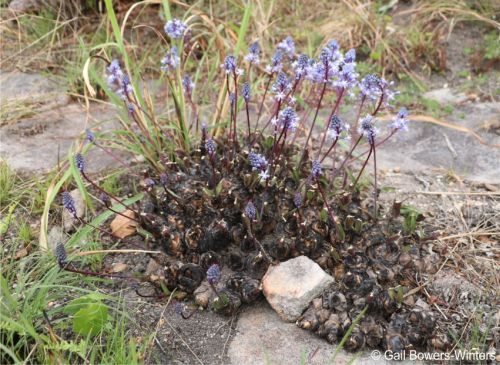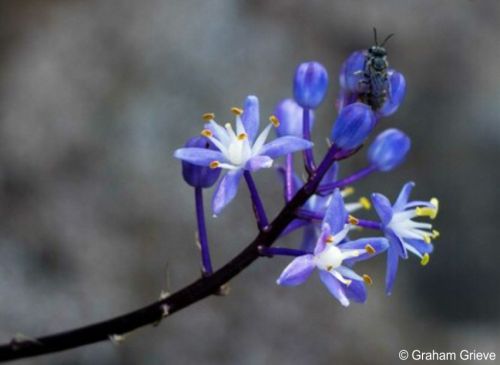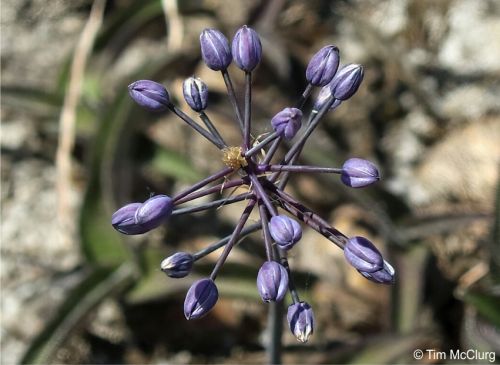Merwilla plumbea subsp. kraussii
Merwilla plumbea (Lindl.) Speta subsp. kraussii (Baker) J.C.Manning
Family: Hyacinthaceae
Common names: dwarf blue squill, wild squill, dwarf scilla (Eng.); kleinblouslangkop, kleinblouberglelie (Afr.); ichitha, inguduza (isiZulu)
Introduction
Falling under one of the most complicated genera, Merwilla plumbea subsp. kraussii, small as it is, sure has a lot of potential to be a rewarding pot plant and puts on a show.

Description
Description
Merwilla plumbea subsp. kraussii is a variable bulbous plant with violet blue flowers. The small bulb grows between 20–40 mm in diameter and it is covered by layers of papery tunics. It produces 2 to 4 sub-erect or spreading leaves, arranged in a rosette. The strongly ribbed leaves grow between 60–100 mm long and 5–10 mm wide, have maroon horizontal lines below or on both sides, and they are covered with small hairs on both sides. Depending on where it occurs, the leaves can be green or deep purple in colour.

The purple and leafless flower stem grows between 150–400 mm long, crowned with flowers on stalks between 10–15 mm long, with 6 violet blue or purple petals of about 5–6 mm long. Flowering is in spring and early summer. After pollination, it produces capsulated fruits that contain black seeds.

Some smaller varieties of Merwilla plumbea subsp. plumbea, from near coastal KwaZulu-Natal and Eastern Cape can not be differentiated from Merwilla plumbea subsp. kraussii. The subsp. plumbea differs because it has 3 to 8 leaves, growing 100–450 mm long and 20–100 mm wide, that are hairless or may be covered with short hairs on one or both sides. The inflorescence is usually taller, at 300–1 500 mm long. Pedicels are 10–30 mm long and flowers with petals 6–10 mm long.
Conservation Status
Status
The Red List of South African Plants online is in the process of being updated and to date, Merwilla plumbea subsp. kraussii is not yet reflected as a separate taxon, but is still included under Merwilla plumbea, which is assessed as Near Threatened (NT). The conservation status of this subspecies has yet to be assessed, but it can be regarded as being Near Threatened (NT), as it is on iNaturalist. Its range is relatively restricted which might hopefully protected it from excessive harvesting.

Distribution and habitat
Distribution description
This squill only occurs in South Africa, and only in two provinces, KwaZulu-Natal and Eastern Cape. It grows at altitudes below 1 000 m, on open stony grounds, rocky hillsides, cliffs and in shallow sandstone soils. Ranging from Nkandla and Krantzkloof to Port Edward and Port St. Johns, it is confined to coastal and near-interior southern KwaZulu-Natal and Eastern Cape. It also occurs in the Karkloof and Noodsberg in KwaZulu-Natal Midlands and in Kokstad in the Eastern Cape. The larger Merwilla plumbea occurs further inland in the Eastern Cape and KwaZulu-Natal. The morphological variations between coastal and inland populations of M. plumbea, were used to identify the coastal populations at a subspecific rank as M. plumbea subsp. krausii.

Derivation of name and historical aspects
History
The name Merwilla is derived from the surname of an amateur botanist Frederick van der Merwe (1894–1968) who studied South African squills and described the genus Schizocharphus, which used to also fall under Scilla. The species name plumbea is from the Latin word which means ‘lead-coloured’ referring to the lead blue flowers. This subspecies is named after Christian Krauss, a German scientist and plant collector who travelled South Africa in 1838 to 1840. Christian, together with William Gerrard, collected the two unlocalised specimens in the mid 1800s, that formed the basis of the description for the former taxon Scilla kraussii.
Both subspecies of Merwilla plumbea were previously known as Scilla natalensis until 1873 when the botanist John Gilbert Baker, segregated smaller forms of Scilla natalensis under Scilla kraussii due to them having approximately 4 hairy leaves 50–80 mm long and a shorter inflorescence 150–200 mm long. It was only distinguished from Scilla natalensis by its smaller size. Since then, additional collections made Scilla kraussii indistinctive from Scilla natalensis which lead Jessop to hesitantly re-unite them in 1970 as a single taxon, Scilla natalensis. In 1989, Speta revised the genus Scilla, recognizing that it is restricted to the Northern Hemisphere and placed the southern African species of Scilla in the genera Merwilla, Schizocarphus and Pseudoprospero. Thus Scilla natalensis became Merwilla plumbea. Jessop’s findings were rejected by Douwes and other authors in 2001 on the basis of limited field observations, and they re-instated this taxon as a subspecies of Merwilla plumbea.

Ecology
Ecology
Like other bulbs, the dwarf blue squill is not so dependent on the summer rains, as are most other plants. It is able to draw moisture from its own reserves and resprout in spring, before it rains.

Uses
Use
The dwarf blue squill can be used in a rockery garden, but it is best grown in pots. Just like Merwilla dracomontana, it is not as popular as the robust large blue squill, Merwilla plumbea in the horticulture industry, however its smaller size make it more manageable for smaller gardens and pot collections.
The closely related Merwilla plumbea is known to be poisonous to humans and livestock, and is fatal to sheep. Although it is poisonous, it is very popular in the traditional medicine industry. There is no evidence of Merwilla plumbea subsp. krausii being used in traditional medicine. However, the plant does have properties that suggest it could have potential uses. It contains alkaloids and have been shown to have anti-inflammatory properties.

Growing Merwilla plumbea subsp. kraussii
Grow
Merwilla plumbea subsp. kraussii can be propagated through seed or bulb division. The plant is also relatively easy to cultivate, and it thrives in a well-draining soil mix. The plant requires moderate water and plenty of light. Merwilla plumbea subsp. kraussii is a popular choice for home gardeners and landscapers as its attractive foliage and stunning blue and purple flowers add a touch of beauty and colour. The plant is also used widely in South African festivals and traditional occasions such as weddings and other cultural celebrations.
This is a low maintenance plant. It is medium resistant to drought and frost. It is a summer grower and should be watered from spring to summer, untill the leaves die back. They are best kept cool and dry in winter or reduce watering. Over watering in winter will cause the bulb to rot.
Propagating Merwilla plumbea subsp kraussii is relatively easy. It can be propagated by seeds or by dividing the bulbs. Seeds can be collected from the plant once they have matured and can be sown in well-drained potting soil in spring. After germination, the bulblets should be left undisturbed and will flower in the third or fourth season.
A well drained mix is crucial, otherwise the roots and bulb will rot. An organic fertilizer can be applied during the active growth period to enhance plant vigour. Additionally, protection from frost is crucial, as the plant is sensitive to freezing temperatures.
The mother bulb creates bulblets at the base, and they can be removed and replanted during winter, when they are dormant. When planting, the top of the bulb should be at or just below the ground level. The plant requires a sunny or partially shaded location. It is also adaptable to container cultivation, making it suitable for indoor gardening. This genus is not susceptible to significant pests and diseases.
References
- Baker, J.G. 1873. Revision of the genera and species of Scilleae and Chlorogaleae. Journal of the Linnean Society, Botany 13: 209–292.
- Bowers-Winters, G. 2022-09-1. Observation of Merwilla plumbea subsp. kraussii, Port Shepstone, KwaZulu-Natal. iNaturalist. Online. https://www.inaturalist.org/observations/133789162.
- Bowers-Winters, G. 2023-08-14. Observation of Merwilla plumbea subsp. kraussii, Port Shepstone, KwaZulu-Natal. iNaturalist. Online. https://www.inaturalist.org/observations/178332761.
- Goldblatt, P. & Manning, J. 2000. Cape Plants. A conspectus of the Cape flora of South Africa. Strelitzia 9. National Botanical Institute, Pretoria & Missouri Botanical Garden, Missouri.
- Grieve, G. 2019-08-14. Observation of Merwilla plumbea subsp. kraussii, Umtamvuna Nature Reserve, KwaZulu-Natal. iNaturalist. Online. https://www.inaturalist.org/observations/144841809.
- Grieve, G. 2022-10-9. Observation of Merwilla plumbea subsp. kraussii, Umtamvuna Nature Reserve, KwaZulu-Natal. iNaturalist. Online. https://www.inaturalist.org/observations/138262215.
- Kellerman, T., Coetzer, J.A.W., Naude, T.W. & Botha, C.J., 2005. Plant poisonings and mycotoxicoses of livestock in southern Africa. Ed. 2. Oxford University Press Southern Africa.
- Manning J.C. 2019. Systematics of the sub-Saharan African squills: The genera Merwilla, Pseudoprospero, Schizocarphus and Spetaea (Hyacinthaceae: Scilloideae). South African Journal of Botany 125: 411–426.
- McClurg, T. 2019-10-6. Observation of Merwilla plumbea subsp. kraussii, Umtamvuna Nature Reserve, KwaZulu-Natal. iNaturalist. Online. https://www.inaturalist.org/observations/148442614.
- McClurg, T. 2019-10-6. Observation of Merwilla plumbea subsp. kraussii, Umtamvuna Nature Reserve, KwaZulu-Natal. iNaturalist. Online. https://www.inaturalist.org/observations/177153765.
- Mucina, L. & Rutherford, M.C. (eds) 2006. The vegetation of South Africa, Lesotho and Swaziland. Strelitzia 19. South African National Biodiversity Institute, Pretoria.
- Pooley, E. 2003. Mountain flowers, a field guide to the flora of the Drakensberg and Lesotho. Natal Flora Publications Trust, Durban.
- Powrie, F. 1998. Smaller bulbs of South Africa. Tafelberg, Cape Town.
- Young, A. 2009-10-14. Observation of Merwilla plumbea subsp. kraussii, Ingomankulu, uMgungundlovu District Municipality, KwaZulu-Natal. iNaturalist. Online. https://www.inaturalist.org/observations/165901870.
- Williams, V.L., Cunningham, A.B. & Raimondo, D. 2008. Merwilla plumbea (Lindl.) Speta. National Assessment: Red List of South African Plants version 2020.1. Accessed on 2023/09/29.
Credits
Dineo Dibakwane and Ndiyafhi Muthuhadini
Walter Sisulu National Botanical Garden
October 2023
Acknowledgements: the authors thank Gail Bowers-Winters, Alison Young, Graham Grieve and Tim McClurg for making their pictures available on iNaturalist.
Plant Attributes:
Plant Type: Bulb
SA Distribution: Eastern Cape, KwaZulu-Natal
Soil type: Sandy, Loam
Flowering season: Spring, Early Summer
PH: Acid, Neutral
Flower colour: Blue, Purple, White
Aspect: Full Sun
Gardening skill: Average
Special Features:
Horticultural zones








Rate this article
Article well written and informative
Rate this plant
Is this an interesting plant?
Login to add your Comment
Back to topNot registered yet? Click here to register.